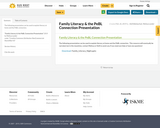
The following presentation can be used to explain literacy at home and the PeBL connection.
- Subject:
- Education
- Material Type:
- Primary Source
- Date Added:
- 02/26/2019

The following presentation can be used to explain literacy at home and the PeBL connection.

In this facilitator’s guide, you will find:
-A comprehensive Read and Rise program overview.
-Helpful tips for planning your program.
-A list of program materials and resources.
-A step-by-step outline and talking points to help you conduct a successful program.

The First Nations Performance Indicators Checklist is a culturally relevant tool that communities can use to assess their educational strengths and weaknesses, and to develop programs to enhance educational success from a First Nations perspective.
The checklist will help communities to understand the circumstances characterizing their educational systems and create a basis for adopting and implementing a model for continuous improvement in their educational systems based on culturally appropriate approaches.

"Humor, goofiness, joy, fun — these were actually vital to developing a creative classroom culture. When I taught middle school, we had a wordplay wall at the back with ridiculously bad dad jokes (things like “fire drill” and “slow jams” and “graduated cylinder”). We had Easter Eggs hidden throughout the classroom. We had our own version of a Rick Roll. If someone asked you to “share a link,” you had to “Cher a link” instead, sending them to a music video from Cher. "
This excellent resource includes videos, and some reading. It's very engaging - and fun! It's all about bringing joy to your classroom - which happens to spark community, creativity and foster risk taking! Win win win!

Access leadership and HR courses. You will need to sign up to enrol.
Courses offered include:
*Discovering and implementing core values
*Align your organization
*Build a 1 page strategic plan
*Personality testing
*How to delegate
*Assessing a team
*Performance reviews & More!

A short video about teaching students with trauma.

"With VR and AR, teachers are no longer limited by the space of the classroom. VR lets you explore the world virtually while AR brings abstract concepts to life—allowing teachers to guide students through collections of 360° scenes and 3D objects, pointing out interesting sites and artifacts along the way."
You will have to download the app to use this from the app store (available for andriod and IOS).
Copy and paste this url into a browser to see the massive list of tours that are available!
Currently there are 900 trips! https://docs.google.com/spreadsheets/d/1uwWvAzAiQDueKXkxvqF6rS84oae2AU7eD8bhxzJ9SdY/htmlview?sle=true#gid=0
To experience VR you will need Expeditions app, a mobile device or Chrome OS, and optional - a VR viewer
SUN WEST - Contact Doug or Terry to bring this to your school!
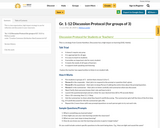
This is a low organization, high impact strategy to use for reflection and discussion in your classroom.

In this article Lee Taal examines" Canada has a problem: we need more workers." A number of challenges are considered.

"While Canadian society is growing more diverse and inclusive, there is still resistance when it comes to supporting lesbian, gay, bisexual, trans, queer, and two-spirit (LGBTQ2) youth in schools. Although recent research indicates that the vast majority of Canadian teachers (85%) now support LGBTQ2-inclusive education, many report not yet having the knowledge or training to feel confident in creating safer and more inclusive schools for LGBTQ2 youth.
Here are four key factors that can make a positive difference for LGBTQ2 students in K-12 schools"

Eleven of the ninety-four Calls to Action of the Truth and Reconciliation Commission of Canada (TRC) final report are specific to education. Call to Action 63, “Building student capacity for intercultural understanding, empathy, and mutual respect,” challenges Canadian education systems to focus on students’ understanding of Indigenous human rights and social justice initiatives. Non-Indigenous students are now beginning to learn about the truth of residential schools, treaties and other long-standing issues facing Indigenous communities such as lack of clean drinking water, housing and food shortages. Truth and reconciliation is a spiritual and emotional journey required of all students and educators – from the head to the heart – that will unfold differently for everyone.

In a “post-truth” era where people are increasingly influenced by their emotions and beliefs over factual information, fact and fiction can be difficult to distinguish, and fake news can spread rapidly through mainstream media sources and social networks. Moreover, fake news is often meant to do harm, by tricking us into believing a lie or unfairly discrediting a person or political movement.
Given this malicious intent, students must learn to approach news and information with a critical eye in order to identify intentionally misleading sources (although recent studies confirm that this is an uphill battle for both adults and young people). Teachers therefore play a crucial role in ensuring that their students develop the skills to decipher the many streams of information available to them.

This article from Edutopia examines "What happens when students can opt to skip tests and instead give oral presentations or create art to show what they know?"
This is a good article to get teachers thinking about assessment in new ways.
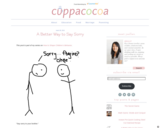
A better way to say sorry.

This article looks at how to personalize learning for secondary students.

Responsive Instruction Modules: Classroom Level Support
Module 1: School-wide Planning - Making Supports and Services a Priority
Module 2: Reading Instruction - Critical Elements
Module 3: Instruction in Mathematics - Effective Instructional Practices
Module 4: Written Expression - Effective Instructional Practices
Inclusive Education Modules
Module 1: School-wide Planning - Making Supports and Services a Priority
Module 2: Fostering Inclusion - Understanding the Classroom Teacher's Role
Module 3: Instructional Support - Engaging Students and Classroom Teachers
Responsive Instruction Modules: Targeted/Group Approaches
Module 1: Targeting Reading Instruction - Knowing Our Learners
Module 2: Targeting Mathematics Instruction - Knowing Our Learners
Module 3: Targeting Written Expression Instruction
Supporting Students with Intensive Needs in the Classroom
Intellectual Disability
Physical Health Impairment
Bipolar Depressive, Anxiety or Related Disorders
Substance Related or Addictive Disorders
Autism Spectrum Disorder
Deaf or Hard of Hearing
Orthopaedic Disabilities
Neurodevelopmental Disorder Associated with Prenatal Substance Exposure
Blind or Visually Impaired
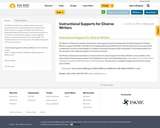
The Ministry of Education’s Student Achievement and Supports branch has developed Instructional Supports for Diverse Writers to support the ESSP’s At Grade Level in Reading, Writing and Math priority. The document focuses on instructional considerations, practices and strategies for students to develop and improve their writing skills. The intended audience for the document is the middle level (grades 4-9) classroom teacher.

"Professor John Hattie and Raymond Smith will introduce mindframes that ensure that leaders at every level can select, implement, and evaluate high-impact interventions that result in systemwide success."
This is a great webinar for division leadership, school based administrators (principals) and triads (school leadership teams).
These high impact mindframes include:
*being an evaluator of my impact on teacher learning
*seeing assessment as informing impact and next steps
*collaborating about progress and impact
*being a change agent and believing all teachers can improve
*strive for challenge
*work with feedback - both giving it and ensuring it's understood by teachers, and also accepting and acting on it when given
*engaging in dialogue
*explicitly informing teachers what success looks like
*build relationships and trust; it's safe to make mistakes and learn from others
*focus on learning

Sign up to receive resources on online safety, screen addiction and metal health.
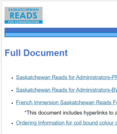
This is a great starting point for administrators when looking to improve and work on literacy in their schools.
Be sure to visit the MODULES section for excellent pre-made modules that will assist you with developing a culture of literacy within your school.
From the site:
"In this continuation of Saskatchewan Reads we have Kim, who is a principal with very little background knowledge in reading. Kim’s ability to provide leadership for a Saskatchewan Reads school is enhanced by following the key components of this document. This resource builds on the sound research from educational leaders such as Routman, Sharratt, Fullan and others. It also provides practical concrete application of promising practises within our province.
This document addresses key areas in being a successful leader within the context of a Saskatchewan Reads school. Some of these key areas include: self-reflection on why leadership is important, how to develop common beliefs, how to be a lead learner and role model, how to create a reading culture and environment, how to lead with a reading focus and how to manage all the different components involved.
The intent of Saskatchewan Reads for Administrators is to provide some very practical tools and processes for administrators at all levels of the system to use in supporting teachers implementing Saskatchewan Reads. The Planning Guidelines are intended to take all the information presented and map out how, when and where it all fits into the school year. It is important to realize that all schools will be at different stages of the journey, thus certain components will take on different levels of priority.
Schools just beginning their journey will not be able to accomplish
everything in one year, therefore chunking different components into a multi-year plan is advised."
(Be patient. It takes a few minutes to load.)